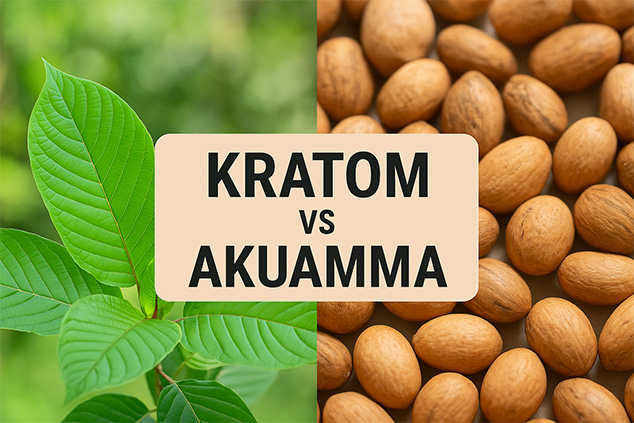While opioid overuse percentage was declining, COVID-19 pandemic and more problematic access to healthcare increased the number of opioid overdoses. Due to the numerous problematic after-effects of taking opioids many seek alternative herbal substitutes to ease pain and achieve other benefits.
Kratom is a popular choice of millions. Yet, akuamma also has its benefits. So, if you need to make the kratom vs. akuamma choice, we’ve prepared a guide for you to clear your doubts and help you make the best choice for you.
What Is Kratom?
Kratom, or Mitragyna speciosa in Latin, is a tropical tree indigenous to Southeast Asia. It grows across countries like Indonesia, Thailand, Myanmar, Malaysia, and Papua New Guinea.
There are other Mitragyna tree varieties in other countries like India, China, and the Philippines. However, those are not Mitragyna speciosa and do not possess the same alkaloids or effects. These varieties can be recognized by their much shorter stature.
Mitragyna speciosa leaves are rich in many different alkaloids. 7-hydroxymitragynine, which is approximately 13 times stronger than morphine, and mitragynine are the most abundant ones, attributing to kratom most of its properties.
Kratom comes in three natural types of vein, as well as many strains. Depending on the vein type as well as the dosage of kratom effects vary.
Red vein kratom is soothing, relaxing, and pain-relieving, whereas white vein kratom is energizing and mood-boosting. Green vein kratom offers the best of the two. You can expect moderate pain relief combined with improved mood, more energy, and more focus and productivity.
How to Take Kratom?
Kratom farmers grind up kratom leaves into a fine powder. Then, it’s available for sale in raw powder form. Some vendors also offer kratom capsules as well as kratom extracts and resins.
There are several ways in which to take kratom. These include brewing kratom tea, mixing kratom with drinks like yogurt, juice, and smoothies. The Toss and Wash method when one swallows kratom followed by water or juice is another popular method.
When taking kratom, an accurate dosage is necessary. Fast strains like whites require a lower dose. Meanwhile, moderate greens require a medium done, while reds need a high dose for the most potent effects.
It is easy to mismeasure kratom dosage, for instance, using a spoon; so, using a sensitive digital scale is the best option. Moreover, one should keep a record of the dosage they take so that they do not develop kratom tolerance. Kratom is a member of the same plant family as coffee, long term exposure can lead to the body getting used to the alkaloids and developing tolerance.
What Is Akuamma?
Akuamma, or Picralima nitida in Latin, is a tall tropical African tree. It grows in various countries in Africa, such as Ghana, Ivory Coast, Gabon, Nigeria, Uganda, Caremoon, and more. The seeds fro the akuamma tree are dried and crushed or powdered and used in traditional medicine across West Africa.
The seeds are rich in alkaloids such as akuammine and pericine. Due to the effects of the alkaloids, many use akuamma to treat malaria and a number of diseases caused by parasites. That’s because of its anti-parasitic effects. Akuamma can also treat diarrhea as well as to relieve pain. Similarly to kratom, akuamma also has relaxing and sedative effects.
Because of its pain-relieving properties, akuamma can serve as a kratom alternative.
How to Take Akuamma?
Most commonly available akuamma comes in capsules that contain powdered seeds. However, it is also possible to buy ground powder and whole seeds. Seeds can be later ground up using a coffee grinder. If you do so, it is essential to measure akuamma dose correctly using a sensitive digital scale.
The powder from akuamma seeds is rather bitter, making capsules more palatable.
Just like it is with kratom, precise akuamma dosage is important. An excessive dose can lead to negative side effects such as nausea, vomiting, and headaches.
Moreover, taking large doses, such as above 6 grams can increase the risk of respiratory depression and can cause liver cell damage. Overdose can also increase sodium and potassium levels in the blood, which can disturb ion regulation.
Users should begin with a small dose and build up over time. 250-500 mg is a good place to start. Though, if you suffer from severe chronic pain, a larger dose may be necessary. Yet, do not exceed 6-8 grams as that can significantly increase the risks.

Kratom vs. Akuamma: Which Is Best for You?
1. Effects and Possible Risks
While kratom vs. akuamma both can be extremely beneficial, kratom offers much more versatile effects than akuamma. Most analgesic akuamma effects resemble those of red vein kratom. However, if you are looking for additional effects like increased energy and focus, then akuamma cannot provide those.
Kratom may also be a better option for those with severe chronic pain and liver issues. That’s because these people may require a larger dose, which could be potentially damaging to the liver.
Since akuamma is relaxing and sedative, it’s more suitable for the nighttime. So, those looking for daytime benefits may benefit more from kratom.
Nonetheless, akuamma could potentially be a seamless substitute to red vein kratom if the person needs to take a break from kratom. While akuamma would not provide all spectrum of kratom benefits, it could help in easing intolerable pain and providing relaxation.
2. Duration
The duration of kratom vs. akuamma effects are not the same either. Fast kratom strains usually last a shorter period of time, while some moderate and slow strains can last an entire night. Akuamma duration, however, is about three to four hours. This longer duration of kratom can be more beneficial for certain conditions such as restless leg syndrome that prevents one from getting proper rest.
4. Legalities
While none of the products are controlled by the FDA, the chance of buying contaminated kratom or ending up with a fake vendor is much higher with kratom. That is, however, mainly due to its high popularity and many bad players looking into was of exploiting the situation.
Luckily, the American Kratom Association and its initiatives, like the Kratom Consumer Protection Act, are providing buyers with more transparency and security.
After reviewing kratom vs. akuamma, it’s apparent that both herbs have different properties, and one may need more than one alternative to kratom to gain the exact same effects.
Nonetheless, akuamma is worth exploring for those who’d like a kratom alternative for days when they do not take kratom. It could also be a good alternative for pain relief for those living in regions where kratom is banned.
Have you tried kratom vs. akuamma? What has your experience with them been? Which herb do you favor and why?



Leave a Reply